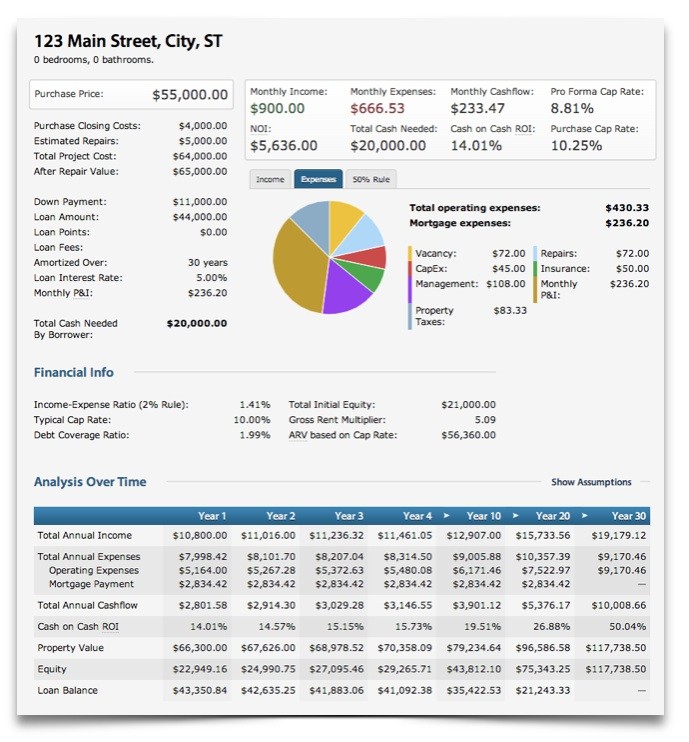How To Easily Calculate The ReturnOnInvestment (ROI) For Rental Properties
Post on: 23 Май, 2015 No Comment

Updated on December 3, 2011 by Jay Castillo 71 Comments
ADVERTISEMENT
As promised, I shall be sharing in this post how I calculate the Return-On-Investment or ROI that I could get for a property. To better illustrate the computation, we will use an actual example which I earlier introduced in Pre-auction bids – Another lesson learned. For this example, I shall be using the buy-and-hold strategy as the property shall only be rented out. I personally favor properties that are profitable as rental properties because this strategy is actually the last resort in case a property takes too long to sell.
Here are the assumptions we shall be using: A small condo unit with an area of 22sqm is being sold for only Php14,000/sqm or about Php308,000. According to the bank agent, rentals of studio units in this area of Makati are between P8,000 to P10,000 per month. For this example let’s use the more conservative estimate of P8,000 per month or P96,000 per year.
If I decide to hire a property manager, property management costs would be around P1,000 per month or P12,000 a year.
Let’s also build a maintenance reserve fund at P1,000 a month or P12,000 a year.
For rental properties, never assume that a property will always be tenanted 100% of the time so for this example, I shall be using a conservative assumption of 1 month of vacancy per year.
Real Property Taxes are estimated to be around P9,000 per year.
Lastly, property insurance would be around P1,000 per year.
As I have mentioned in Five Things to Consider when Buying Foreclosures. Capital Gains Tax and Documentary Stamps Tax (DST) should also be considered as these are very significant just in case these are for the account of the buyer. For this example, CGT and DST are for the account of the seller so there is no need to include them.
Scenario 1: I shall pay in cash
The Annual Net Income would be as follows:
Annual Rental Income-P 96,000.00
1 Month vacancy(8000.00)
Property management-(12,000.00)
Maintenance reserve(12,000.00)
Real Property Tax(9,000.00)
Insurance-(1,000.00)
___________________________________
Annual Net IncomeP54,000.00
This Annual Net Income is also equal to the annual passive income.
As mentioned in the book “Think Rich Pinoy!” by Larry Gamboa, you calculate the cash-on-cash ROI by dividing the annual passive income by the money you have out at the end of the first year or the Total Cash Invested which is equal to the selling price of P308,000 as I decided to pay in cash for this example.
ROI = Net Income / Total Cash Invested x 100%
= 54,000/308,000 x 100%
With a projected ROI of around 17.53% per year, this sounds good! But what if I decided to use leverage and pay in installments?
Scenario 2: Use leverage and pay through bank financing
If I paid through bank financing, my 10% down payment would only be P30,800 which results in a balance of P277,200. With a bank loan at 11% interest per annum and a loan term of 10 years, the monthly amortizations would be Php3,318.43 or Php39,821.16 per year. You can use a mortgage calculator which can be found here to get the monthly amortizations.
The Annual Net Income would then be as follows:
Annual Rental IncomeP96,000.00
Annual Amortizations(39,821.16)
1 Month vacancy(8,000.00)
Maintenance reserve(12,000.00)
Real Property Tax-(9,000.00)
Insurance(1,000.00)
__________________________________
Annual Net Income-P14,179.00
For this case, the Total Cash invested is only the 10% Down payment which is P30,800
ROI = Annual Net Income/Total Cash Invested x 100%
= 14,179/30,800 x 100%
While the Annual Net Income amount when using leverage maybe small compared to the Annual Net Income amount when paying in cash, in terms of ROI, it looks a lot better at 46.04%. This means for each peso invested when using leverage, earnings are higher as compared to paying in cash.
I would like to emphasize that the initial investment was a mere P30,800 only, which is the 10% down payment! This illustrates the power of leverage. For this particular example, the property appears to be a good investment as a rental property.
If you find the computations to be intimidating, don’t be! You can always use an excel sheet and this can be done in a few minutes. In fact, you can download a sample excel file here. Just plug in your own numbers and feel free to play around with it.
As you can see, the numbers really show if a property is a good buy or not and is a much more objective means of comparing it with other investment alternatives like stocks, bonds, mutual funds, certificate of deposits, etc.
You can also use this to validate claims of some sellers/developers that their properties are good investments because of a high ROI. Take a look at their computations and make sure that factors like taxes, property management costs, and other expenses are considered.
In my next series of posts, I’ll show you how the numbers would look like using the other common investment strategies like rent-to-own, rehabbing, and wholesaling. I’m quite sure many of you will be surprised. So dont forget to subscribe to my mailing list so you wont miss them. If your mailbox is getting full, you may also subscribe via RSS reader .
P.S. I’ll also be discussing CWT in the next posts with the help of my wife. This was requested by Betty. Sorry I wasn’t able to include it here as my wife wants to review BIR’s revenue regulations first just to be sure well have an accurate example.
*Update Some of you might be asking how about repairs and marketing costs? For this example, I did not include these as the unit was in pretty good shape and marketing can be done using the free services of sulit.com.ph and buyandsellph.com
Last updated by Jay Castillo on December 3, 2011 .














